
NGC 4605 is a dwarf barred spiral galaxy in the constellation Ursa Major, located at a distance of 18.1 ± 0.3 megalight-years from the Milky Way. Physically it is similar in size and in B-band absolute magnitude to the Large Magellanic Cloud. It is a member of the M81 Galaxy Group, along with Messier 81 and Messier 101.

NGC 3632 and NGC 3626 is an unbarred lenticular galaxy and Caldwell object in the constellation Leo. It was discovered by William Herschel, on 14 March 1784. It shines at magnitude +10.6/+10.9. Its celestial coordinates are RA 11h 20.1m, dec +18° 21′. It is located near the naked-eye-class A4 star Zosma, as well as galaxies NGC 3608, NGC 3607, NGC 3659, NGC 3686, NGC 3684, NGC 3691, NGC 3681, and NGC 3655. Its dimensions are 2′.7 × 1′.9. The galaxy belongs to the NGC 3607 group some 70 million light-years distant, itself one of the many Leo II groups.

NGC 6263 is an elliptical galaxy in the constellation Hercules. It was discovered by Albert Marth on June 28, 1864.
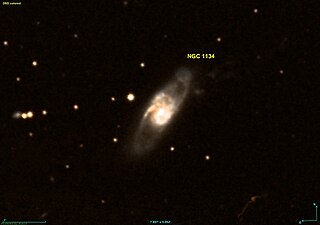
NGC 1134 is a spiral galaxy in the Aries constellation. It has a highly inclined disk, with respect to the line of sight from Earth. There is a weak outer extension of the spiral structure in this galaxy. It has been listed in the Arp Atlas of Peculiar Galaxies, under the "Galaxies with material ejected from nuclei" section. NGC 1134 is classified as a galaxy with reduced surface brightness, and it possesses a distinct bulge in its centre, as judged by photometric analysis. It has a small and distant companion about 7' to the south.
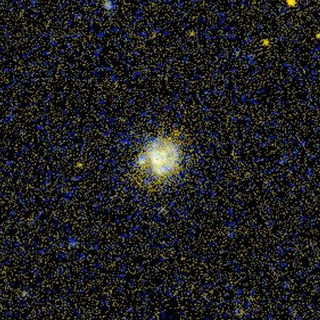
NGC 5665 is a spiral galaxy in the constellation of Boötes.

NGC 5490 is a radio galaxy in the constellation Boötes.

NGC 3539 is a lenticular galaxy in the constellation Ursa Major. It was discovered in April 1831 by John Herschel. It is a member of the galaxy cluster Abell 1185.

NGC 4666 is a spiral galaxy in the equatorial constellation of Virgo, located at a distance of approximately 55 megalight-years from the Milky Way. It was discovered by the German-born astronomer William Herschel on February 22, 1784. It is a member of the Virgo II Groups, a series of galaxies and galaxy clusters strung out from the southern edge of the Virgo Supercluster. John L. E. Dreyer described it as "bright, very large, much extended 45°±, pretty suddenly brighter middle". It is a member of an interacting system with NGC 4668 and a dwarf galaxy, and belongs to a small group that also includes NGC 4632.

NGC 4866 is an unbarred lenticular galaxy located roughly 100 million light-years away in the constellation Virgo. It was first observed by British astronomer Sir William Herschel on January 14, 1787. It is a member of the Virgo Cluster.
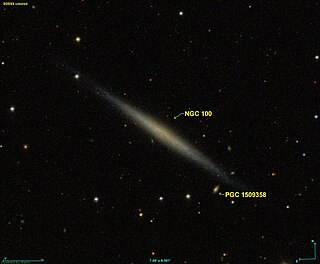
NGC 100 is a galaxy located approximately 60 million light-years from the Solar System in the constellation Pisces. It has an apparent magnitude of 13.2. It is located at RA 24min 2.6s, Dec +16°29'11". It was first discovered on 10 November 1885 by American astronomer Lewis Swift.

NGC 4485 is an irregular galaxy located in the northern constellation of Canes Venatici. It was discovered January 14, 1788 by William Herschel. This galaxy is located at a distance of 29 million light years and is receding with a heliocentric radial velocity of 483 km/s.

NGC 79 is an elliptical galaxy estimated to be about 270 million light-years away in the constellation of Andromeda. NGC 79 is its New General Catalogue designation. Its apparent magnitude is 14.9. It was discovered on 14 November 1884 by Guillaume Bigourdan.
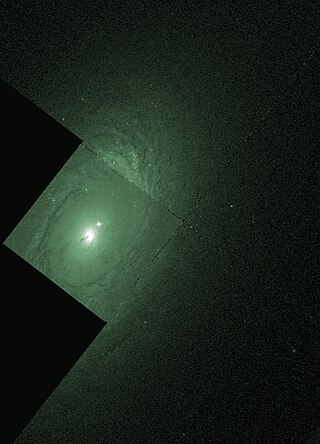
NGC 4138 is the New General Catalogue identifier for a lenticular galaxy in the northern constellation of Canes Venatici. Located around 52 million light years from Earth, it spans some 2.1 × 1.3 arc minutes and has an apparent visual magnitude of 11.3. The morphological classification of NGC 4138 is SA0+(r), indicating it lacks a bar formation and has tightly wound spiral arms with a ring-like structure around the nucleus. It has no nearby companion galaxies.
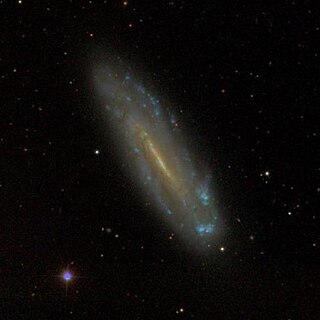
NGC 4178 is the New General Catalogue identifier for a barred spiral galaxy in the equatorial constellation of Virgo. It was discovered April 11, 1825 by English astronomer John Herschel. Located some 43.8 million light years away, this galaxy spans 2.3 × 0.4 arc minutes and is seen at a low angle, being inclined by 77° to the line of sight from the Earth. The morphological classification of NGC 4178 is SB(rs)dm, indicating that it has a bar feature at the core, and, per the '(rs)', has traces of a ring-like structure surrounding the bar. The 'dm' suffix indicates the spiral arms are diffuse, broken, and irregular in appearance with no bulge at the nucleus. This galaxy is a member of the Virgo Cluster, which is the richest nearby group of galaxies outside the Local Group and forms the core of the Virgo Supercluster.

NGC 4203 is the New General Catalogue identifier for a lenticular galaxy in the northern constellation of Coma Berenices. It was discovered on March 20, 1787 by English astronomer William Herschel, and is situated 5.5° to the northwest of the 4th magnitude star Gamma Comae Berenices and can be viewed with a small telescope. The morphological classification of NGC 4203 is SAB0−, indicating that it has a lenticular form with tightly wound spiral arms and a weak bar structure at the nucleus.

NGC 5470 is an edge-on spiral galaxy located between 43 and 68 million light-years away in the constellation Virgo. It was discovered by astronomer John Herschel in 1830. It is a member of the Virgo III Groups, a series of galaxies and galaxy clusters strung out to the east of the Virgo Supercluster of galaxies.

NGC 701 is a spiral galaxy with a high star formation rate in the constellation Cetus. It is estimated to be 86 million light years from the Milky Way and has a diameter of approximately 65,000 light years. The object was discovered on January 10, 1785 by the German-British astronomer William Herschel.
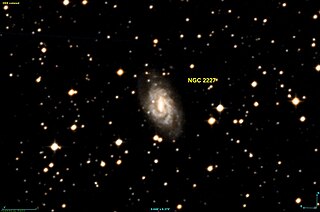
NGC 2227 is a barred spiral galaxy with a morphological type of SB(rs)c located in the direction of the Canis Major constellation. It was discovered on January 27, 1835, by John Herschel.
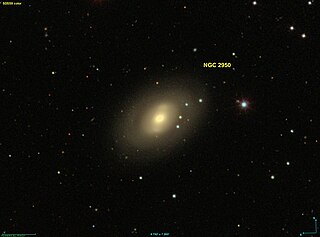
NGC 2950 is a lenticular galaxy in the northern constellation of Ursa Major, about 50 million light years from the Milky Way and receding with a heliocentric radial velocity of 1,329 km/s. It was discovered in 1790 by the Anglo-German astronomer William Herschel. NGC 2950 is a field galaxy, it is not part of a galaxy cluster or galaxy group, and thus is gravitationally isolated. Nine certain and four possible dwarf galaxies have been identified around NGC 2950.
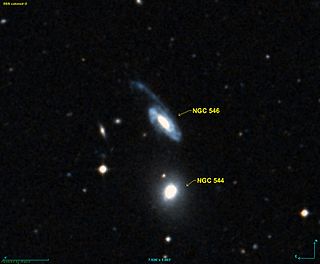
NGC 546 is a barred spiral galaxy about 270 million light years away from Earth and located in the constellation Sculptor. The largest diameter is 1.40 and the smallest is 0.5 angular minutes. The first discovery was made by John Frederick William Herschel on 23 October 1835.





















